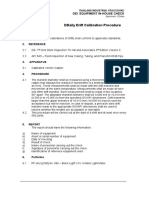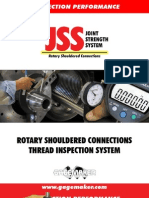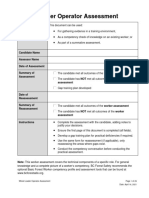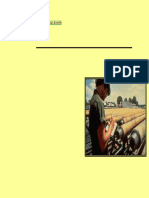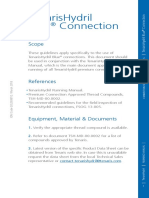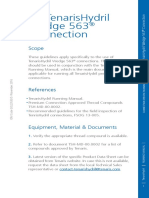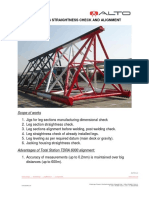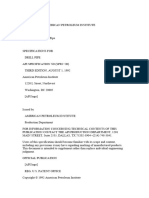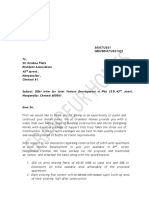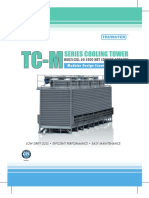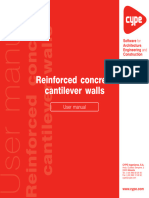BVM Corporation Maintenance Manual: "C", "T", & "MP" Series Safety Clamps
BVM Corporation Maintenance Manual: "C", "T", & "MP" Series Safety Clamps
Uploaded by
RakefsCopyright:
Available Formats
BVM Corporation Maintenance Manual: "C", "T", & "MP" Series Safety Clamps
BVM Corporation Maintenance Manual: "C", "T", & "MP" Series Safety Clamps
Uploaded by
RakefsOriginal Description:
Original Title
Copyright
Available Formats
Share this document
Did you find this document useful?
Is this content inappropriate?
Copyright:
Available Formats
BVM Corporation Maintenance Manual: "C", "T", & "MP" Series Safety Clamps
BVM Corporation Maintenance Manual: "C", "T", & "MP" Series Safety Clamps
Uploaded by
RakefsCopyright:
Available Formats
BVM Corporation Maintenance Manual
“C”, “T”, & “MP” SERIES SAFETY CLAMPS
For 1-1/8” through 43”
Part number: __________________ Serial Number: ________________
Safety
CAUTION: Practice safety in the operation and maintenance and use only approved
safety methods, materials and tools. Keep hands away from any pinch point or
undesignated areas; use only the provided handles for operating the Safety Clamp.
WARNING: Safety Clamps which have experienced wear beyond established wear
criteria set by OEM, or are found to have cracks must be replaced or repaired by a BVM
authorized repair facility.
WARNING: Only original BVM parts may be used. Safety Clamps are produced from
cast alloy heat treated steel and must not be welded in the field. Improper welding can
cause cracks and brittleness in heat-affected areas which can result in dramatic weakening
of the part and possible failure. Repairs involving welding and/or machining should be
EN D 001 Rev C Page 1 of 8
performed only by a BVM authorized repair facility. Using a Safety Clamp that has been
improperly welded or repaired is dangerous.
NOTE: The owner and user together with the manufacturer should jointly develop and
update inspection, maintenance, repair and remanufacture procedures consistent with
equipment application, loading, work environment, usage and other operational
conditions. These factors may change from time to time as a result of new technology,
equipment history, product improvements, new maintenance techniques and changes in
service conditions.
Confidentiality Statement
This document contains proprietary and confidential information, which is the property of
BVM Corporation. No use or disclosure is to be made without the express written consent
of BVM Corporation.
Note: Original Instructions are published in English; in the event the end-user may wish to
obtain a translation of these in the official language of the country in which the machinery is to
be used please contact your local BVM representative or BVM directly. Please note that this
service may not be free of charge. Original Instruction can be downloaded from
www.bvmcorp.com
Contents
Safety ............................................................................................................................................. 1
Purpose .......................................................................................................................................... 2
Description ..................................................................................................................................... 2
Operation ....................................................................................................................................... 3
Lubrication ..................................................................................................................................... 3
Inspection & Maintenance ............................................................................................................. 4
Wear data ....................................................................................................................................... 6
Critical Area Drawings .................................................................................................................. 7
Troubleshooting ............................................................................................................................. 7
Risk Assessment According to EN-ISO 12100:2010 .................................................................... 8
Assembly drawing and List of Parts .............................................................................................. 8
Purpose
This manual contains operation, inspection and service instructions for Type “C”, “T”, and
“MP” Safety Clamps.
Description
BVM offers safety clamps for tubing (T) and casing (C). Multipurpose (MP) safety clamps are
adjustable to a variety of tubular. The clamp has its own box with a nut wrench and an allen
wrench. Manual clamps are equipped with screw and nut combination. The nut secures the
EN D 001 Rev C Page 2 of 8
clamp around the pipe and should be tightened with the supplied nut wrench. The clamp grips
uniformly by design. The individual links give the clamp flexibility to wrap around the pipe and
the inserts are spring loaded.
CE Marking (if applicable):
Operation
To open the T and C type clamp, pull the end link pin. On the MP, loosen the nut, releasing
tension so it can swing open. Holding the handles, wrap the clamp around the pipe like a belt.
Insert pin or on MP, push the screw back into the screw latch link segment, turning the nut to
tighten. Use wrench to torque nut. The end user determines the clamping torque necessary to
prevent marking/damaging tubular.
With the clamp installed, the spring loaded tapered inserts are designed to firmly grip and
wedge against the tubular as the load increases or as the tubular slips down. As the load
increases, the spring tension will result in a tighter grip that prevents further travel.
Warning:
• Safety Clamps are not designed to hold or hoist the string weight – use in conjunction
with slips.
• Safety Clamps are made from cast alloy steel and should not be welded in the field.
Improper welding can cause cracks and brittleness in repaired area and can result in
drastic weakening of the Safety Clamp and Parts and possible Failure.
• Repairs which involve welding and or machining by others that is not authorized by
BVM will void the warranty.
• Using Safety Clamp which has been improperly welded can result in serious bodily harm
and property damage.
• Use the handles for lifting the Safety Clamp.
• Only use the Safety Clamp within the specified temperature rating, which is -4°F to
150°F unless otherwise specified.
Note: If a Safety Clamp is used despite the above warnings BVM voids all warranties.
Lubrication
Lubricate the Safety Clamp regularly during usage and storage to prevent corrosion. Use a high
grade multi-purpose lubricant which is compatible with the expected ambient temperatures on:
• Intermediate/End/Screw Pins
• Insert/link contact surfaces
• Screw
Unpainted surfaces should be coated with a rust preventing agent.
EN D 001 Rev C Page 3 of 8
Inspection & Maintenance
Safety should be practiced at all times when servicing the equipment always use BVM
Corporation, approved safety methods, material and tools. Always wear protective gear for
eyes, head and hands.
This is a suggested PM schedule. The tool owner has the responsibility to adjust the program
according to actual tool usage.
Daily Inspection (when in use)
1. Check for any worn and damaged parts.
2. Check for loose and missing parts.
3. Check to make sure all cotter pins are in place and installed properly with the ends
spread out to prevent pull out.
4. Clean inserts and inspect for wear and missing teeth – if found, replace.
5. Inspect the contact surface of the insert slots.
6. Press inserts down and release – inserts should come up if springs are operational –
replace spring or clean further if necessary.
7. Check for any visible cracks.
8. Check for any corrosion.
9. Check state of lubrication.
10. Open and close the clamp completely several times to check for binding. The clamp
should open and close with little force. If binding does occur, isolate the area and check
links and pins for corrosion or excessive wear.
Semi-annual inspection
1. Perform daily PM.
2. Check for corrosion and breakage on pins and springs – if found, replace.
3. Perform MPI (magnetic particle inspection) on critical areas.
Caution:
• Use only parts manufactured and sold by BVM Corporation
• Re-machining of parts should be performed only at BVM Corporation. Improper
machining could result in increased stress (Decreased Load carrying capability) or
improper alignment of component parts. Either condition could be hazardous to
personnel and equipment.
• Always wear gloves and eye protection when striking or handling parts.
• Do not use any safety clamp with wear in link, pin, or insert areas. Wear in these areas
will cause Safety Clamp to function improperly and may cause failure.
Magnetic Particle Inspection (MPI)
Carry out MPI according to ASTM E709 or ASME BPVC sub section A, article 7 and
subsection B, article 25; determine the type of defects and the degree by comparing defects to
ASTM E125 reference photographs to the acceptance criteria.
Only cracks may develop and as such need to be reviewed. All other indication types have been
addressed by the manufacturer during production. As such, the Safety Clamp has left the factory
EN D 001 Rev C Page 4 of 8
with indication (if at all) which were deemed acceptable. All cracks which have developed in
service are relevant and need to be examined.
Evaluation of indications:
Relevant indications: Only those indications with major dimensions greater than 1/16 Inch
(1.6mm) and associated with a surface rupture shall be considered relevant. Relevant indications
are indications that results from, discontinuities within the test part. Non relevant indications are
indications that results from excessive magnetizing current, structural design or permeability
variances within the test parts. Any indication believed to be non-relevant shall be regarded as
relevant and shall be re-examined to determine whether an actual defect exists. Linear
indications shall be considered as those having a length of more than three times the width.
Rounded indications shall be considered as those having a length less than three times the width.
A lined indication shall be considered as a group of three more indications which touch an
imaginary straight line connecting any two of the group.
For equipment certified in accordance with API 8A & 8C PSL 1:
Maximum Allowable Degree
Type Discontinuity Descriptions Critical Areas Non-critical Areas
I Hot tears, cracks None Degree 1
II Shrinkage Degree 2 Degree 2
III Inclusions Degree 2 Degree 2
IV Internal chills, chaplets Degree 1 Degree 1
V Porosity Degree 1 Degree 2
For equipment certified in accordance with API 8A & 8C PSL 2:
Maximum Allowable Degree
Type Discontinuity Descriptions Critical Areas Non-critical Areas
I Hot tears, cracks None None
II Shrinkage None Degree 1
III Inclusions Degree 1 Degree 2
IV Internal chills, chaplets None Degree 1
V Porosity Degree 1 Degree 2
Note: Only BVM authorized repair facilities are allowed to repair safety clamps with indications
outside the acceptance criteria.
EN D 001 Rev C Page 5 of 8
Wear data
The inspection data and maximum wear tolerances are only valid if the equipment is in
otherwise good condition and has not been mis-used, does not exibit excessive wear, cracks or
other defects. Additionally any weld repairs – not done at a BVM authorized repair facility –
shall require examination and re-certification by a BVM authorized repair facility before being
used further. These data and tolerances only apply to certain critical components and cannot on
their own determine the overall condition of the equipment or its suitability for continued use.
These data and tolerances are what is required to retain 100% ratings.
Table 1: Wear table
Type T C MP
Part Number 8800x Cx995xx 330xx
Size (") 1-1/8 - 4-1/2 3-3/4 - 43 2-7/8 - 36-1/8
Pin Clearance (A) .045 .045 .040
Insert Clearance (B) .060 .085 .060
Figure 1: Wear variables
EN D 001 Rev C Page 6 of 8
Critical Area Drawings
Figure 2: Link critical area (red) drawings
Troubleshooting
When problems cannot be solved, contact an authorized BVM repair facility.
Overview possible problems:
Problem Possible cause Possible solution
Clamp does not open Corrosion Pry open, clean, and lubricate
Bent/deformed pins Wear Verify pin clearance
Clamp does not hold Undersized tubular Select proper sized clamp
Damaged tubing Overtightened End user to establish suitable torque range
EN D 001 Rev C Page 7 of 8
Risk Assessment According to EN-ISO 12100:2010
The conclusion of the risk assessment is that in general, the crew must:
• Wear person safety protection like safety glasses, hard hats, etc.
• Follow instructions as stated in the manual.
• Have knowledge of rig procedures.
• Must have been instructed for safe use of the tool.
• Perform maintenance and inspection according to this manual.
Applicable standards:
• EN-ISO 12100:2010 Safety of machinery – Basic concepts, general principles for design
– Risk assessment and risk reduction
• Machinery Directive: 2006/42/EC
• API 7K
Assembly drawing and List of Parts
See data sheets at www.bvmcorp.com.
EN D 001 Rev C Page 8 of 8
You might also like
- Cementing Tools: General RequirementsDocument4 pagesCementing Tools: General Requirementsislam atifNo ratings yet
- Electrical SpecificationDocument26 pagesElectrical Specificationsurendramaharjan100% (3)
- Steam Flow Through Safety Valve Vent PipesDocument11 pagesSteam Flow Through Safety Valve Vent PipesminhphuongphamNo ratings yet
- BVM Corporation Maintenance Manual: Series "S" ElevatorDocument11 pagesBVM Corporation Maintenance Manual: Series "S" ElevatorAnang SakraniNo ratings yet
- Manual-18 Rotary Side Door ElevatorDocument12 pagesManual-18 Rotary Side Door ElevatorYesid Cruz Yesid Cruz100% (1)
- MS Tong MaintenanceDocument7 pagesMS Tong MaintenanceBahman MatouriNo ratings yet
- Manual Drill Collar S-R-LDocument6 pagesManual Drill Collar S-R-LJAVIER EDUARDO MANTILLA BUITRAGONo ratings yet
- Leopard General and in Stal Tion InformationDocument18 pagesLeopard General and in Stal Tion InformationChandrasekhar Sonar100% (1)
- Ddaily Drift Calibration Procedure: 1. ScopeDocument1 pageDdaily Drift Calibration Procedure: 1. ScopeJohn DolanNo ratings yet
- Ra Elevatorr Maintenance ManualDocument8 pagesRa Elevatorr Maintenance ManualBahman MatouriNo ratings yet
- Catalogo 511Document4 pagesCatalogo 511Luis Oswaldo R PNo ratings yet
- BHNK Drill Pipe CatalogDocument12 pagesBHNK Drill Pipe CatalogivertianNo ratings yet
- Itag Ibop ValveDocument23 pagesItag Ibop ValveValmac ServicesNo ratings yet
- 20 1703YSeriesElevatorManualDocument27 pages20 1703YSeriesElevatorManualnjava1978No ratings yet
- Safety Clamp Cat. IVDocument6 pagesSafety Clamp Cat. IVRanjithNo ratings yet
- TSH Ip 53.0070 - 01Document4 pagesTSH Ip 53.0070 - 01Cong BuiNo ratings yet
- Maintenance Y SERIESDocument10 pagesMaintenance Y SERIESStowartNo ratings yet
- Slips Maintenance, Inspection, & Wear Data PDFDocument3 pagesSlips Maintenance, Inspection, & Wear Data PDFcorsini999100% (3)
- Certificate of Inspection/ Certificat de Inspectie Sucker Rod Elevator/ Elevator Tiji de PompareDocument2 pagesCertificate of Inspection/ Certificat de Inspectie Sucker Rod Elevator/ Elevator Tiji de Pompareteodorescu MARIUSNo ratings yet
- BVM Corporation Maintenance Manual: Pneumatic / Hydraulic Tubing SpiderDocument17 pagesBVM Corporation Maintenance Manual: Pneumatic / Hydraulic Tubing SpiderDean Rein100% (1)
- TSH Ip 53.0067 - 01Document4 pagesTSH Ip 53.0067 - 01Cong BuiNo ratings yet
- Rotary Sub-Thread Checking Procedure-JSSbrochureDocument4 pagesRotary Sub-Thread Checking Procedure-JSSbrochureMinakshi SawantNo ratings yet
- Manual Elevator Links BVMDocument4 pagesManual Elevator Links BVMJosevan Batista100% (1)
- TSH Ip 53.0064 - 01Document4 pagesTSH Ip 53.0064 - 01Cong Bui100% (1)
- Lift Caps: General RequirementsDocument2 pagesLift Caps: General Requirementsislam atif100% (1)
- B+V Manual - Elevator Links PDFDocument10 pagesB+V Manual - Elevator Links PDFYina UsecheNo ratings yet
- Drilling Hole Opener WebDocument2 pagesDrilling Hole Opener WebBehrangNo ratings yet
- Casing and Tubing Crossovers: ScopeDocument4 pagesCasing and Tubing Crossovers: Scopeislam atifNo ratings yet
- EMI Buggy Cal 5Document2 pagesEMI Buggy Cal 5John DolanNo ratings yet
- Running Procedure: Voestalpine Tubulars GMBH & Co KG Voestalpine Tubulars GMBH & Co KGDocument16 pagesRunning Procedure: Voestalpine Tubulars GMBH & Co KG Voestalpine Tubulars GMBH & Co KGSumesh DethanNo ratings yet
- VFP - Vam Eis - en PDFDocument30 pagesVFP - Vam Eis - en PDFZed ZedNo ratings yet
- Tenaris Running Manual 03Document28 pagesTenaris Running Manual 03Dileep Kumar100% (1)
- Wheel Loader Operator AssessmentDocument29 pagesWheel Loader Operator AssessmentmamuNo ratings yet
- TechScope EZT-IIDocument2 pagesTechScope EZT-IIMIS WORKSHOPNo ratings yet
- Field Inspection of Drillpipe - Summary OverviewDocument33 pagesField Inspection of Drillpipe - Summary Overviewhuyenhvtc252No ratings yet
- TenarisHydril Blue Running GuidelinesDocument12 pagesTenarisHydril Blue Running Guidelinessubodhasingh100% (1)
- Iv-0751-20 Boot Basket Ae63922aDocument1 pageIv-0751-20 Boot Basket Ae63922aivan dario benavides bonillaNo ratings yet
- Fox Public Fox-Tp-M-101 Field InspectionDocument5 pagesFox Public Fox-Tp-M-101 Field InspectionJoseph MidouNo ratings yet
- Rutong DH 吊环使用说明书(ZY)2013 links - 1Document3 pagesRutong DH 吊环使用说明书(ZY)2013 links - 1QAMAR ALI KHANNo ratings yet
- TSH Ip 53.0066 - 02Document5 pagesTSH Ip 53.0066 - 02Cong BuiNo ratings yet
- Safety Clamp: Operation ManualDocument21 pagesSafety Clamp: Operation ManualDavid Venegas AndradeNo ratings yet
- GPDS Connections Field InspectionDocument4 pagesGPDS Connections Field InspectiontheinmoeNo ratings yet
- IV-0794-20 CROSS OVER Pin-Box 05807HDocument1 pageIV-0794-20 CROSS OVER Pin-Box 05807Hivan dario benavides bonillaNo ratings yet
- Catalog Elevator LinkDocument70 pagesCatalog Elevator LinkSandra RamirezNo ratings yet
- Field Inspection Procedure For Used GPDS Connections Revision 03 PDFDocument3 pagesField Inspection Procedure For Used GPDS Connections Revision 03 PDFJohn Dolan0% (1)
- 4 DP VX-39 Dogis Pipe. Drift ID. With Int. Coated PipeDocument3 pages4 DP VX-39 Dogis Pipe. Drift ID. With Int. Coated Pipeyatinbhat100% (2)
- ET7000 Ops PDFDocument20 pagesET7000 Ops PDFSUSHIL CNo ratings yet
- Calibration Certificate of Weight IndicatorDocument1 pageCalibration Certificate of Weight IndicatorHaseeb ManzoorNo ratings yet
- TenarisHydril Wedge 563 RunningGuidelinesDocument16 pagesTenarisHydril Wedge 563 RunningGuidelinesDario JaimesNo ratings yet
- 4068 Jack Up Leg Straightness and Alignment 2Document4 pages4068 Jack Up Leg Straightness and Alignment 2karthi keyanNo ratings yet
- B+V Manual - CLS 100-150 - 621100-Y-BC-D Rev 005Document30 pagesB+V Manual - CLS 100-150 - 621100-Y-BC-D Rev 005Leonardo Rachen RodriguezNo ratings yet
- Iv-0204-21 Fishing Magnet 54313haDocument1 pageIv-0204-21 Fishing Magnet 54313haivan dario benavides bonillaNo ratings yet
- FA5i MR PDFDocument2 pagesFA5i MR PDFpramodh kumarNo ratings yet
- Receipt Inspection NS2A4Document11 pagesReceipt Inspection NS2A4islam atifNo ratings yet
- Sub-Spec 023 - Tenaris DSTJ, WT™Document4 pagesSub-Spec 023 - Tenaris DSTJ, WT™Josue FishNo ratings yet
- Iv-0777-20 Junk Mill 43350KDocument1 pageIv-0777-20 Junk Mill 43350Kivan dario benavides bonillaNo ratings yet
- Drill Pipe Connection Care and HandlingDocument20 pagesDrill Pipe Connection Care and HandlingGuzman CharlesNo ratings yet
- Iv-0779-20 Taper Mill Ah09271Document1 pageIv-0779-20 Taper Mill Ah09271ivan dario benavides bonillaNo ratings yet
- 5DDocument37 pages5Dabdalla el-saadaneyNo ratings yet
- Measurement While Drilling: Signal Analysis, Optimization and DesignFrom EverandMeasurement While Drilling: Signal Analysis, Optimization and DesignNo ratings yet
- H Tong Maintenance ManualDocument8 pagesH Tong Maintenance ManualBahman MatouriNo ratings yet
- Operation Manual: YM16-II B3 Hydraulic CatheadDocument8 pagesOperation Manual: YM16-II B3 Hydraulic CatheadRakefsNo ratings yet
- Pipe Spinner (Pneumatic)Document1 pagePipe Spinner (Pneumatic)RakefsNo ratings yet
- Detailed Specifications For Pneumatic Drill Pipe SpinnerDocument3 pagesDetailed Specifications For Pneumatic Drill Pipe SpinnerRakefsNo ratings yet
- JOT Power Slip LifterDocument2 pagesJOT Power Slip LifterRakefsNo ratings yet
- Ezy Torque Pan IndustriesDocument1 pageEzy Torque Pan IndustriesRakefsNo ratings yet
- Api 5CDocument12 pagesApi 5CRakefsNo ratings yet
- Safety Clamp CatalogDocument90 pagesSafety Clamp CatalogRakefsNo ratings yet
- VSM 300 Shaker ScreenDocument1 pageVSM 300 Shaker ScreenRakefsNo ratings yet
- Catalogue Page of Hydraulic Power Casing TongDocument1 pageCatalogue Page of Hydraulic Power Casing TongRakefsNo ratings yet
- Tank Arrangement: 1. Active SystemDocument5 pagesTank Arrangement: 1. Active SystemRakefsNo ratings yet
- Lecture 12: Building Technology and Strategies For SustainabilityDocument39 pagesLecture 12: Building Technology and Strategies For Sustainabilitypil;zoNo ratings yet
- Pelletizer Gala 12S EN SDocument12 pagesPelletizer Gala 12S EN SJR De la PazNo ratings yet
- HT-Projects (CEP)Document4 pagesHT-Projects (CEP)Ahmed ChohanNo ratings yet
- Proposal Letter 43rd Street NanganullurDocument9 pagesProposal Letter 43rd Street NanganullurSathya NarayananNo ratings yet
- Catalogues - LBC Tower - TCM SeriesDocument12 pagesCatalogues - LBC Tower - TCM Seriesyêu animeNo ratings yet
- Annexure-A: # Group Item Description Material Specification Existing Fire Properties Values Test Method PL No. Unit QPCDocument20 pagesAnnexure-A: # Group Item Description Material Specification Existing Fire Properties Values Test Method PL No. Unit QPCAbhey DograNo ratings yet
- Refrigeration IIAR 4 PR1Document28 pagesRefrigeration IIAR 4 PR1geverett2765100% (3)
- MANUAL - DaMPeR MODULE 7 PRE-EARTHQUAKE EVALUATION OF BUILDINGS Rev2019 0115Document44 pagesMANUAL - DaMPeR MODULE 7 PRE-EARTHQUAKE EVALUATION OF BUILDINGS Rev2019 0115Mars TinNo ratings yet
- Basics of Foundry LadlesDocument9 pagesBasics of Foundry LadlesArpan DasNo ratings yet
- Be SG Frick lccs-2019Document8 pagesBe SG Frick lccs-2019elionoeNo ratings yet
- Halfen DT 23-ENDocument36 pagesHalfen DT 23-ENAngelo VieitoNo ratings yet
- Engineering Fracture Mechanics Prof. K. Ramesh Department of Applied Mechanics Indian Institute of Technology, MadrasDocument29 pagesEngineering Fracture Mechanics Prof. K. Ramesh Department of Applied Mechanics Indian Institute of Technology, MadrasPranav RaveendranNo ratings yet
- TutorialDocument32 pagesTutorialCorrado MulasNo ratings yet
- Chapt 10Document22 pagesChapt 10yaori700% (1)
- Durock Cement Board Installation Guide en CB237Document8 pagesDurock Cement Board Installation Guide en CB237Alhilali ZiyadNo ratings yet
- Lecture Note XDocument40 pagesLecture Note XChristian NwekeNo ratings yet
- AR09JSALBWKXCV - Novus Technical Data BookDocument27 pagesAR09JSALBWKXCV - Novus Technical Data BookFernando CabreraNo ratings yet
- Riya Enterprises: EstimationDocument2 pagesRiya Enterprises: Estimationabhi100% (1)
- FlukeDocument4 pagesFlukeFlorin PetreNo ratings yet
- Deflection of BeamDocument5 pagesDeflection of BeamMax LuxNo ratings yet
- StruBIM Cantilever Walls - Reinforced Concrete Cantilever Walls - User ManualDocument16 pagesStruBIM Cantilever Walls - Reinforced Concrete Cantilever Walls - User ManualAHMAD BALFAQIHNo ratings yet
- 1.5 Types of Portland CementDocument16 pages1.5 Types of Portland Cementm_zaimieNo ratings yet
- Drymix Mortar Yearbook 2019: IdmmcDocument8 pagesDrymix Mortar Yearbook 2019: Idmmcnagesh raoNo ratings yet
- Investigation and Minimization of Slag Spot Surface Defects in Continuous Casting of High Carbon Steel Billets Through Statistical EvaluationDocument11 pagesInvestigation and Minimization of Slag Spot Surface Defects in Continuous Casting of High Carbon Steel Billets Through Statistical EvaluationJorge MadiasNo ratings yet
- JE!Tnh: Essential e MomentDocument1 pageJE!Tnh: Essential e Momentpmali2No ratings yet
- Inam Ullah (Civil Engineering Internship Report)Document31 pagesInam Ullah (Civil Engineering Internship Report)Salman Ali100% (1)
- Encased Stone Column With Different Modulus Elasticity of The GeotextileDocument24 pagesEncased Stone Column With Different Modulus Elasticity of The GeotextileHoihogo Hoi100% (1)
- New Hampshire Department of Transportation: Substructure DetailsDocument4 pagesNew Hampshire Department of Transportation: Substructure Detailsجميل عبد الله الحماطيNo ratings yet








